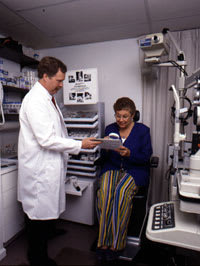FOCUS ON LOW VISION
Low vision and macular degeneration affect millions of Americans. Still, few opticians, whether employed by doctors or independent, have tapped into low vision.
"It is an area that should be growing, but it's not," says Ray Dennis, coordinator of the opticianry program, "Ophthalmic Design and Dispensing," at Middlesex Community College in Middletown, Conn. "Opticians have been slow to recognize the potential of this business."
Eyecare Business spoke with five opticians across the country who have committed to focusing part of their efforts on low vision patients. Many say this niche can be a profit center. But better yet, most agree that while it can be one of the most challenging areas, low vision is definitely the most satisfying part of their business.
"It is a difficult field but an extremely gratifying one," says Bruce Linder, owner and optician at Linder Opticians in Baltimore. "When you succeed you can change people's lives in a dramatic way. I look at it as success through altruistic motives and not mercenary motives."
Getting involved: Five Opticians Share Their Experiences
By Erinn Morgan

Photo courtesy of Eschenbach
Getting Started
Mike Myers, owner and optician at Myers Opticians in Las Vegas, recalls how to get started. "Someone had come into my office about nine years ago asking about low vision devices and I referred her to an association for the blind. She called back later crying from happiness that someone had finally given her a resource to get some help.
I decided then that it was time to get into it," he says.
Linder says he has been treating low vision patients for as long as he has been in business-more than 30 years. But his real focus on building this niche came about four years ago when he began to notice some specific improvements made in the field. "In particular, I saw advances in digital magnifiers," he says. "The price of these devices had dropped significantly." He says he subsequently spent a "small fortune stocking these devices and trying to find out everything that was available, reading about it, and attending different seminars."
Knowledge is certainly critical in this field, where it is important to be up to date on the most advanced low vision devices that can help your patients. Getting started in low vision most often means first coordinating with an O.D. or M.D. who can provide a low vision exam for this patient and offer them treatment advice. It also requires an investment in devices.
"When Dr. Hobart in our office started doing low vision exams 27 years ago," recalls Bill Rusin of Security Optometric in Binghampton, N.Y., "he was struggling even to meet costs on items. But now it's different. It's a practice builder and a service to the area. But mostly it's a commitment of time. You have to keep up to date, spend time going to seminars, and stock a proper inventory."
Some have even seen fit to make this growing area their main focus. MagnifEYErs in Ft. Lauderdale, Fla. is a new low vision venture including a doctor, dispensing staff, and rehab specialists. "It is really special," says optician Jerry Mansell. "We have a whole team of rehabilitation experts who can give patients hour upon hour of training."
Marketing Tips
Those who have made the commitment to include low vision in an existing business say it accounts for anywhere from five to 30 percent of their total volume. "It is growing all the time for us," says Myers, whose low vision business accounts for about 30 percent of his dispensing volume.
"We are even looking to expand the low vision area."
Attracting patients to create volume is certainly a major marketing challenge. Organizing a referral system with other optical professionals who do not handle low vision patients is one sure way to create a strong flow of patients. However, most practitioners agree that it is a challenging network to form.
"It's been a long, hard, arduous process to communicate to other people in the area that their patients can be handled elsewhere when they can't help them anymore," says Rusin. "Ophthalmologists in our area are now great with referring but that was a hard place to get." Rusin, like many others, also coordinates with the local and state associations for the blind.
Security Optometric, however, is soon starting a year-long TV ad campaign which will stress low vision as one of the things that makes their practice unique.
Another challenge is getting these patients back for follow-up sessions. Says Mansell, "by the time the doctor does his two-hour exam and evaluation they come out to me and are pretty tired. I sometimes go over things with them for up to two to three hours, so it's tough to do this all in one visit." To get them back for follow-up, MagnifEYErs is organizing a transportation system to send from their office.
At the ophthalmic practice of Drs. Fava and Maria in Lebanon, Pa., a new computer system helps them to better keep track of low vision patients and maintain patient retention. Additionally, the doctors often speak at local functions to promote the low vision end of their business. "There's a macular degeneration support group that meets every three to four months at one of the local nursing homes," says Bev Heishman, optician, buyer and office manager. "Dr. Maria will be speaking at a meeting coming up in a few weeks."
Building and growing low vision business is not easy. But, say those who've done so, it's well worth the effort.



